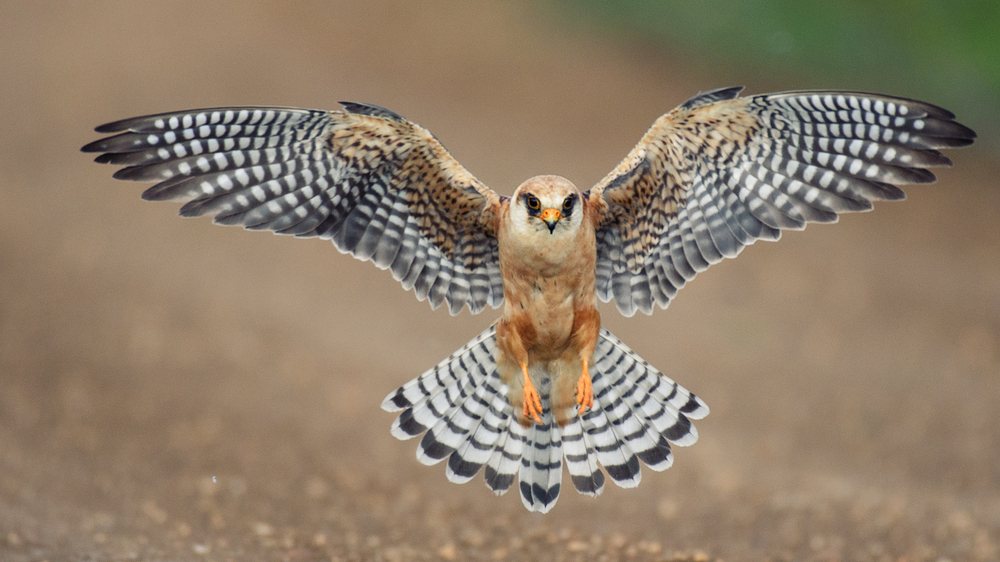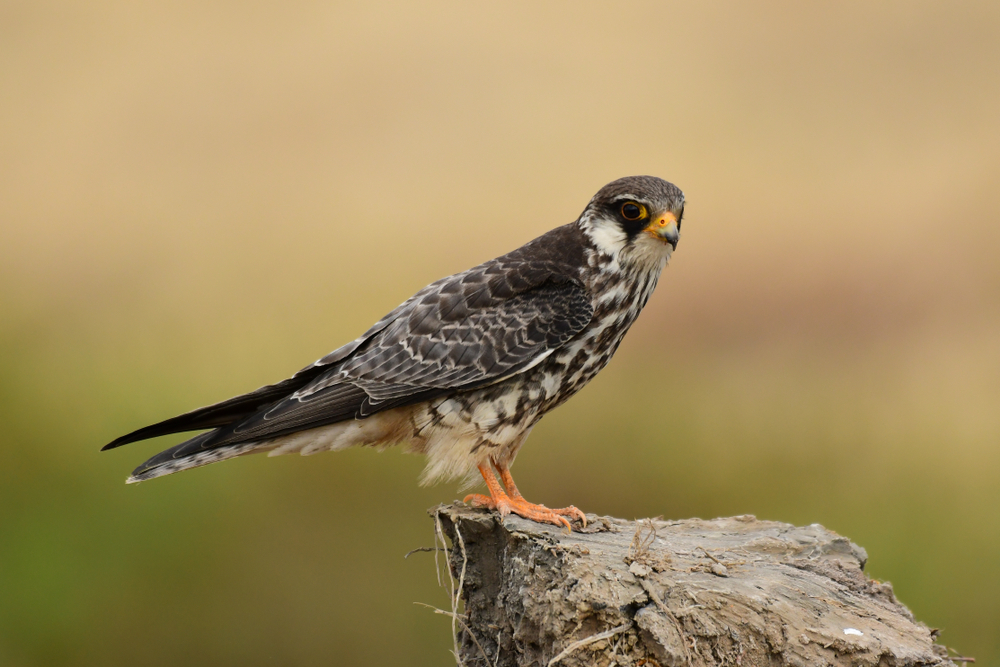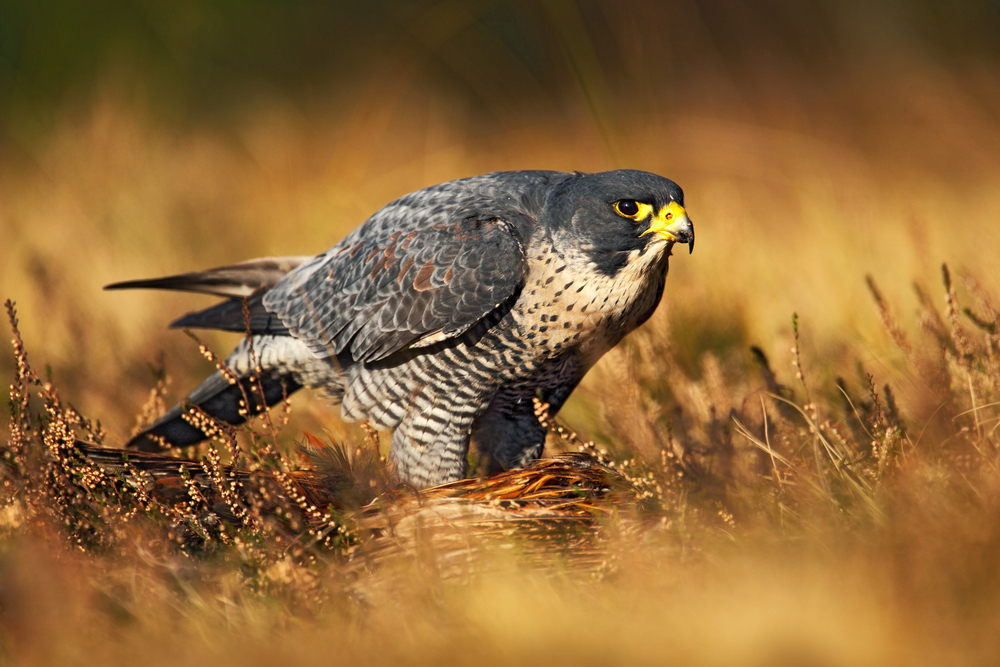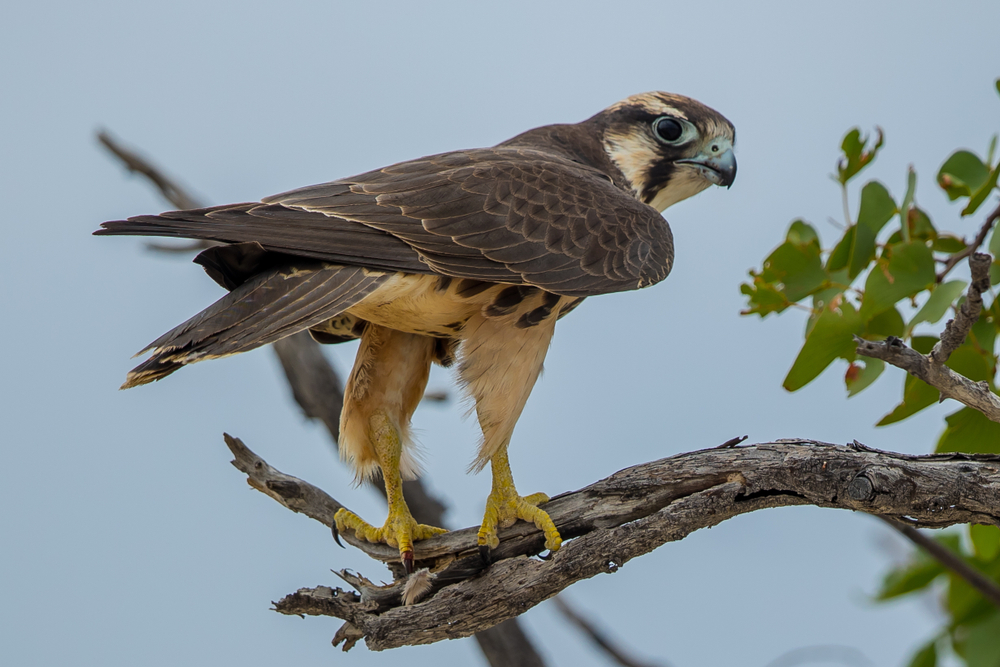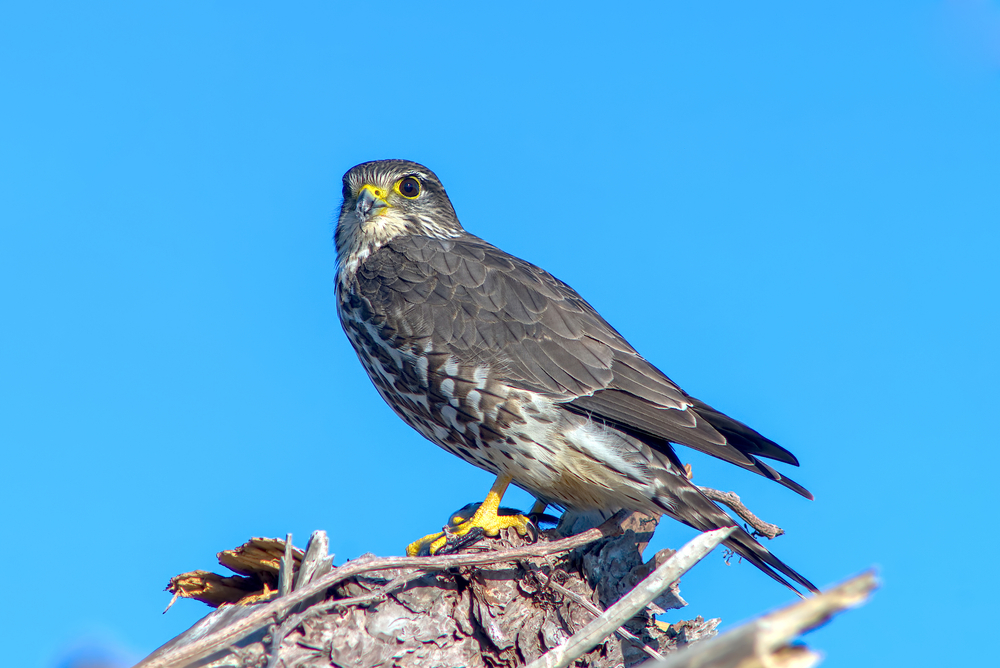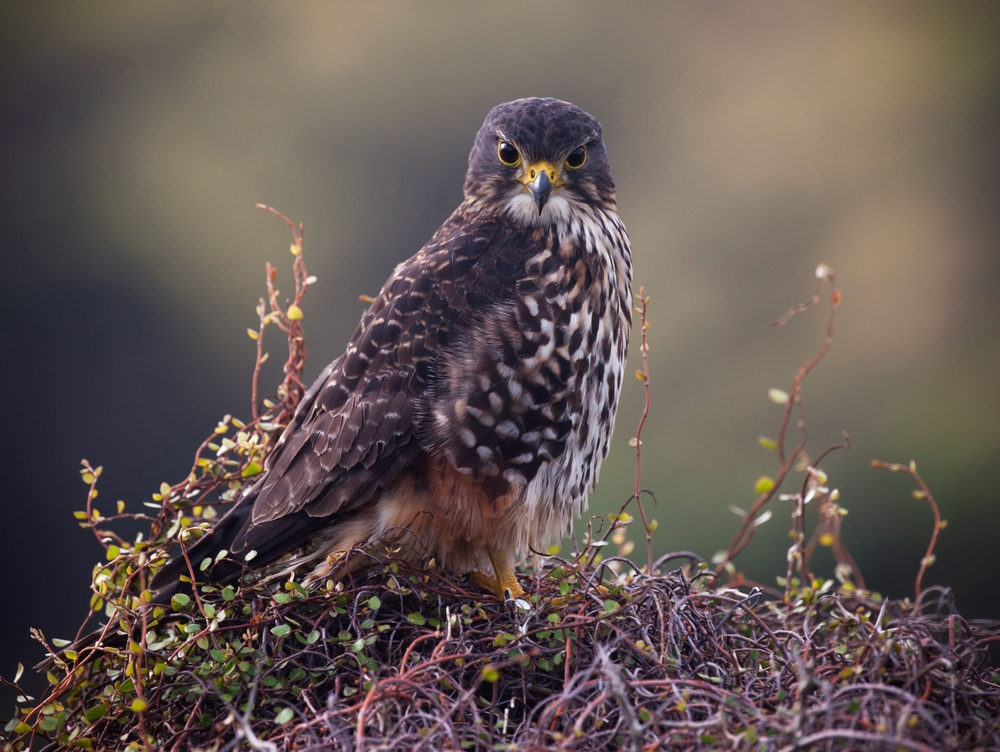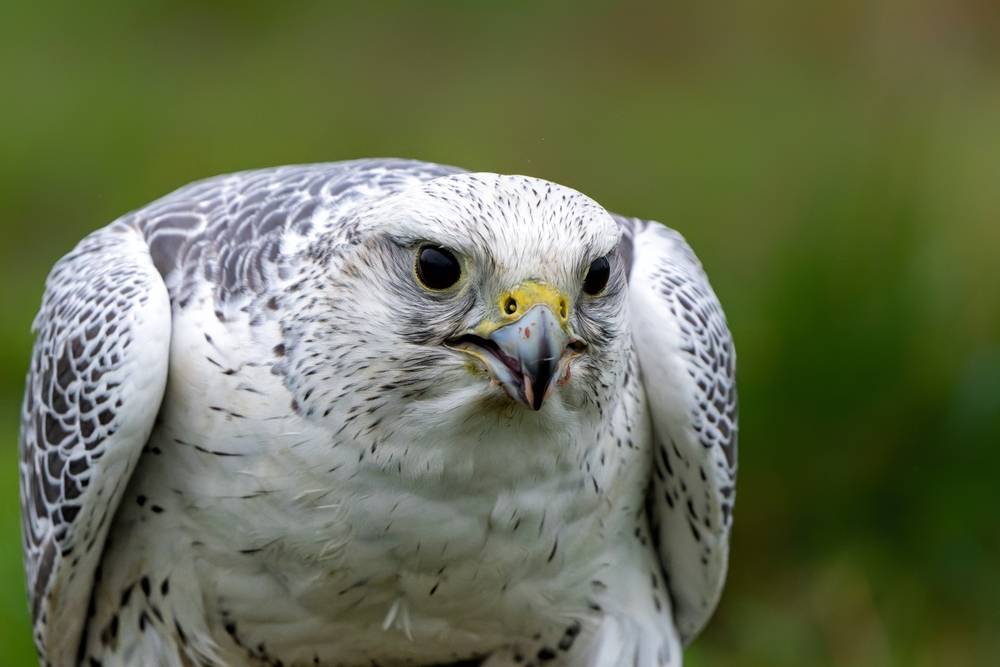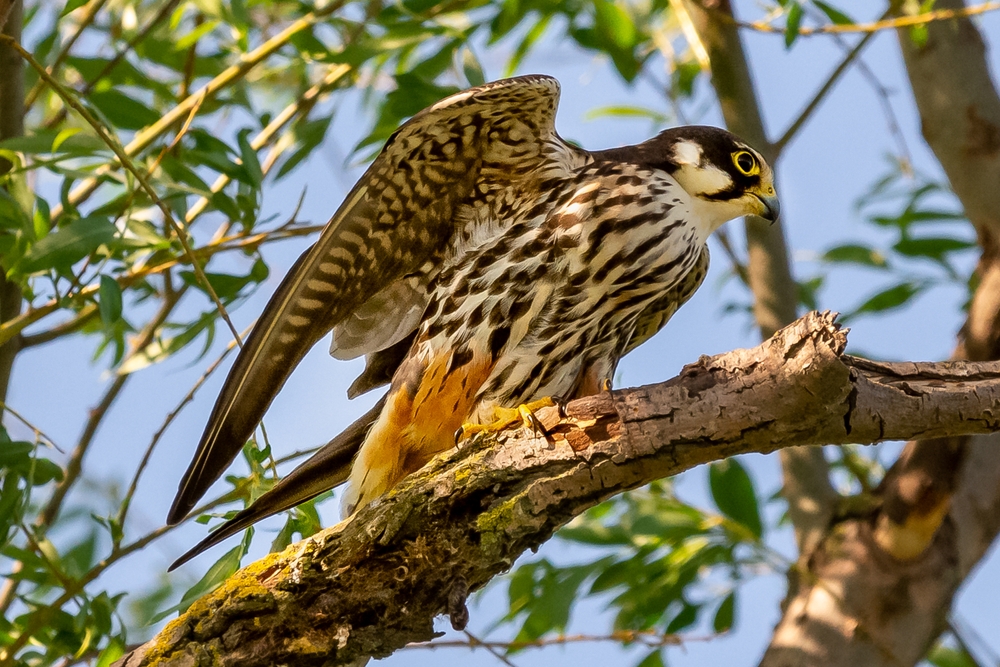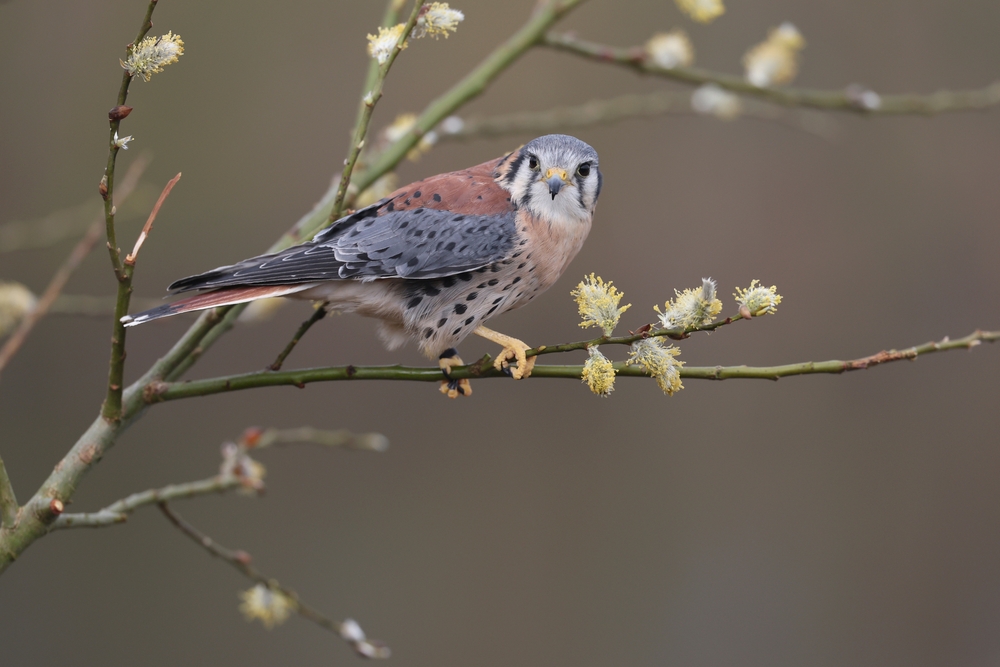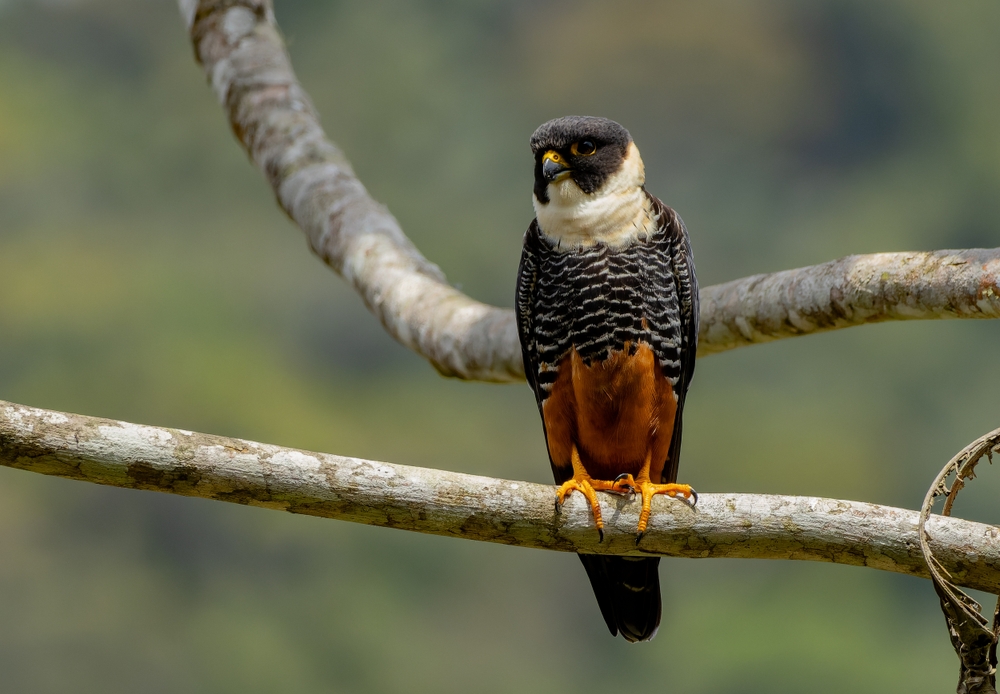The Red-footed Falcon (Falco vespertinus) is most closely related to the Amur Falcon (Falco amurensis), which shares a similar size, appearance, and insect-based diet, and also migrates long distances to southern Africa.
About
The Red-footed Falcon (Falco vespertinus), part of the Falconidae family, is a small, graceful raptor native to eastern Europe and Asia, with migratory routes stretching to southern Africa. This striking falcon is admired for its aerial agility, communal roosting behavior, and beautiful plumage.
Adult males are particularly distinctive, with slate-blue plumage contrasted by bright red legs, feet, and eye-rings. Females are more patterned, with orange underparts and a gray back, while juveniles show a mixture of browns and rufous tones. With a wingspan of 65–75 cm (26–30 in) and a body length of about 28–34 cm (11–13 in), the Red-footed Falcon is slightly smaller than the Eurasian Kestrel but shares a similar slim, pointed-wing silhouette.
This falcon primarily feeds on insects, particularly locusts, grasshoppers, and dragonflies, but will also capture small birds, reptiles, and rodents. Its hunting style often includes hovering over fields or hawking insects mid-air, making it an important species for natural pest control.
Breeding typically occurs in colonies, often using abandoned nests of rooks or other corvids in trees. The female usually lays 3–5 eggs, with both parents sharing incubation and care of the chicks. Social by nature, Red-footed Falcons often roost and hunt in groups, an unusual trait among falcons that underscores their cooperative tendencies.
This species is highly migratory, traveling thousands of kilometers each year between breeding grounds in Europe and wintering areas in southern Africa. However, populations have declined in parts of their range due to habitat loss, reduction in insect prey from pesticide use, and destruction of nesting sites. Conservation initiatives, including nest-box programs and habitat protection, are helping to stabilize numbers.
Physical Characteristics
The Red-footed Falcon (Falco vespertinus) is a small, migratory falcon of Eurasia, recognized for its colorful plumage, slender build, and communal roosting behavior.
Plumage:
-
Males: Slate-gray overall with a darker head and orange-red legs, feet, and eye-ring. The underparts are uniform gray, with striking contrast against the red legs and undertail.
-
Females: Very different in appearance, with bluish-gray wings, orange underparts with barring, a pale head, and dark streaks on the crown.
-
Juveniles: Similar to females but duller, with more brownish tones and streaking across the body.
Head and Face:
The head is sleek, with a short, hooked beak. Males show a darker hood, while females display a pale buff or whitish face with streaking.
Body and Wings:
The body is slim and streamlined, with long, pointed wings suited for graceful aerial hunting. They have a buoyant, kestrel-like flight, often with hovering behavior when scanning for prey.
Tail:
The tail is medium-length and narrow, usually gray in males and barred in females and juveniles, aiding in sharp maneuverability.
Size:
-
Length: 11–12 in (28–30 cm)
-
Wingspan: 26–31 in (65–79 cm)
-
Height at Rest: About 11 in (28 cm) when perched
Weight:
-
Adult Male: 4.2–5.3 oz (120–150 g)
-
Adult Female: 5.3–7.0 oz (150–200 g)
The Red-footed Falcon’s distinctive red legs, marked sexual dimorphism, and graceful hovering flight distinguish it from other small falcons. Its elegant shape and colorful contrast make it one of the most striking raptors of the Eurasian skies.
Reproduction
The Red-footed Falcon (Falco vespertinus) breeds in colonies across Eastern Europe and Central Asia, often nesting in association with other raptors and corvids.
1. Mating and Courtship:
They are seasonally monogamous, with courtship involving aerial displays, chases, and food offerings from the male to the female. Males often present prey to females mid-air as part of pair bonding.
2. Nesting Sites:
Red-footed Falcons do not build their own nests. Instead, they use old stick nests made by rooks, crows, or magpies, often nesting in loose colonies within rookeries or groves.
3. Egg Laying:
The female lays 3–5 eggs per clutch, usually in May or June after returning from Africa. Eggs are whitish to pale buff with brownish markings.
4. Incubation:
Incubation lasts about 28–30 days, primarily carried out by the female, while the male provides food and occasionally relieves her at the nest.
5. Hatching and Care of Chicks:
Chicks hatch with pale down and are helpless. The female broods them during the first couple of weeks, while the male provides most of the food. As chicks grow, both parents share feeding responsibilities.
6. Fledging and Independence:
Young falcons fledge at about 27–30 days of age, usually in July. After leaving the nest, they remain dependent on their parents for another 2–3 weeks while they develop hunting skills.
7. Breeding Frequency:
Red-footed Falcons raise one brood per year, their timing tightly linked to summer insect availability on the Eurasian steppes.
The Red-footed Falcon’s colonial nesting behavior, reliance on abandoned rook nests, and strong male provisioning are unique adaptations that improve breeding success in its open-country habitats.
Lifespan
The Red-footed Falcon (Falco vespertinus) has a moderate lifespan for a small migratory falcon, with survival influenced by long-distance migration and habitat pressures.
Lifespan in the Wild:
In the wild, Red-footed Falcons typically live 8–10 years. Many juveniles, however, do not survive their first year due to predation, starvation, or hazards encountered during their migration between Eurasia and Africa. The oldest known wild individuals have reached about 13 years.
Lifespan in Captivity:
In captivity, with consistent food, safety from predators, and veterinary care, Red-footed Falcons can live up to 18 years.
Threats to the Red-footed Falcon:
-
Migration Hazards: Their long migratory journey to and from southern Africa exposes them to exhaustion, storms, and food shortages.
-
Habitat Loss: Agricultural expansion and destruction of rookeries reduce available nesting sites.
-
Pesticides: Chemical use in farmlands reduces insect populations, their primary food source, and can cause poisoning.
-
Predation: Eggs and chicks are vulnerable to corvids, martens, and larger raptors.
-
Climate Change: Altered weather patterns affect the abundance and timing of insect prey, potentially disrupting breeding success.
Despite these challenges, colonial nesting and strong parental cooperation help sustain populations where suitable habitats are preserved.
Eating Habits
The Red-footed Falcon (Falco vespertinus) is an agile hunter that relies heavily on insects, making it one of the most insect-dependent falcons of Eurasia.
Diet:
-
Insects: Dominant in their diet, especially grasshoppers, crickets, locusts, beetles, and dragonflies during summer.
-
Small Vertebrates: Occasionally hunt frogs, lizards, bats, and rodents.
-
Birds: May take small songbirds or nestlings when insects are scarce, particularly during breeding.
Hunting Strategy:
-
Hovering Flight: Like kestrels, they often hover in place, scanning the ground before dropping onto prey.
-
Aerial Hunting: Swift and acrobatic in the air, capable of snatching dragonflies and other insects mid-flight.
-
Perch Hunting: Frequently hunt from exposed perches such as trees, fences, or utility poles, diving quickly onto prey.
Feeding Behavior:
-
Small prey like insects are often eaten on the wing.
-
Larger prey is carried to a perch and plucked before consumption.
-
During the breeding season, males deliver prey to females and chicks, sometimes performing mid-air food passes.
Success and Adaptability:
Their flexible diet and ability to switch between insects, birds, and small vertebrates make Red-footed Falcons highly adaptable. Their colonial lifestyle also benefits hunting, as large groups can take advantage of insect swarms over fields and wetlands.
Uniqueness
The Red-footed Falcon (Falco vespertinus) is a striking and highly social small falcon with several traits that distinguish it from other raptors.
Sexual Dimorphism in Plumage:
Males and females look dramatically different. Males are slate-gray with red legs and undertail, while females are patterned with rufous underparts, gray wings, and a pale streaked head.
Colonial Nesters:
Unlike most falcons, Red-footed Falcons often breed in colonies, typically reusing abandoned rook or crow nests. This communal lifestyle offers protection and increases breeding success.
Insect Dependence:
They are one of the most insect-focused falcons, relying heavily on grasshoppers, dragonflies, and beetles, which they catch in flight or hover-hunt like kestrels.
Long-Distance Migration:
These falcons undertake remarkable migrations, traveling from breeding grounds in Eastern Europe and Central Asia all the way to southern Africa, covering thousands of miles each year.
Aerial Agility:
Their hovering ability and acrobatic insect-catching make them among the most graceful falcons to watch, with a hunting style more delicate than larger falcons like Peregrines.
Conservation Importance:
Habitat loss and agricultural changes have reduced their populations in parts of Europe, making them a focus for conservation efforts, including nest box programs and rookery protections.
The Red-footed Falcon’s striking plumage, colonial lifestyle, and insect-specialized diet make it one of the most unique and charismatic falcons of the Old World.
Be the First to Share Photos of This Species.
FAQ’s
1. What is the species closest to the Red-footed Falcon?
2. How does the Red-footed Falcon compare to other falcons?
The Red-footed Falcon is smaller and more insect-dependent than most falcons. Unlike Peregrines that stoop on birds, Red-footed Falcons rely heavily on hovering and aerial agility to catch insects, resembling kestrels in hunting style.
3. Which national parks provide the best opportunities to see a Red-footed Falcon?
Which national parks provide the best opportunities to see a Red-footed Falcon?
-
Hortobágy National Park (Hungary): A stronghold for breeding colonies in Europe.
-
Puszta National Parks (Hungary/Romania): Grasslands with nesting colonies in old rook nests.
-
Kiskunság National Park (Hungary): Known for active conservation of colonial rookeries.
-
Kruger National Park (South Africa): A key wintering site where they gather in large flocks.



































































